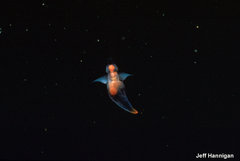Clionidae
|
|
| Clionidae | ||||||||||||||
|---|---|---|---|---|---|---|---|---|---|---|---|---|---|---|
 Clione limacina | ||||||||||||||
| Scientific classification | ||||||||||||||
| ||||||||||||||
| Genera | ||||||||||||||
The sea angels of the family Clionidae (Rafinesque, 1815) are gelatinous, mostly transparent pteropods. They only have shells in their embryonic stage. They are very small, with the largest species (Clione limacina) reaching 5 cm. They use their winglike flaps for rhythmical locomotion, as if flying in the sea. These wings are attached to the anterior part of the body. The posterior part is gelatinous and mostly transparent. The orange visceral sac is confined to the anterior part. Mating is done ventrally for mutual fertilization. The following spring, this results in a free-floating, gelatinous egg mass.
A more comprehensive discussion can be found under the entry Sea angel.
Clionidae , d'Orbigny, 1851 is also the name of a family of boring sponges from the order Hadromerida, class Demospongiae. Within the ICZN there has been a proposed emendation of spelling to Clionaidae for this sponge family.
Genus Clione Pallas, 1774
ClioneLimacina.(cropped).jpg
- Clione antarctica Smith, 1902 (former synonym of Clione limacina australis (Bruguière, 1792))
- Distribution : Antarctic and Subantarctic waters, Alaska, Canada, Northern Europe.
- Length : 4.2 cm
- Description: This species is an important component of polar ecosystems. It feeds on the pteropod Limacina helicina; but further north it feeds on Limacina retroversa as well. It is eaten itself by the medusa Dipulmaris antarctica. It defends itself from predators by synthesizing an ichthyodeterrent (= deterring fishes) compound, a previously unknown molecule, named pteroenone. It acts as guest for the hyperiid amphipod Hyperiella dilatata, which takes advantage of the protection offered.
- Clione limacina Phipps, 1774 Naked Sea Butterfly, Common Clione
- Distribution : mostly in cold waters, as the Arctic Ocean and Antarctic waters; also in Northern Atlantic and Eastern Pacific temperate waters.
- Length : max. 5 cm
- Description : They aggregate sometimes in considerable numbers before the coasts of Northern Europe; They feed in a predator-prey relationship primarily on the sea butterfly Limacina helicina. Both species are on the menu of planktonic feeders, such as the baleen whales. The feeding process of Clione limacina is somewhat extraordinary. The buccal apparatus consists of three pairs of buccal cones. These tentacles grab the shell of Limacina helicina. When the prey is in the right position, with its shell opening facing the radula of Clione limacina, it then grasps the prey with its chitinous hooks, everted from hook sacs. Then it extracts the body completely out of its shell and swallows it whole. The neurobiology of this pteropod has been studied in detail.
Genus Fowlerina Pelseneer, 1906
- Fowlerina punctata Tesch, 1903
- Fowlerina zetesios Pelseneer, 1906
Genus Paedoclione Danforth, 1907
- Paedoclione doliiformis Danforth 1907
- Distribution : Western Atlantic, Oceanic
- Length : 1.5 mm
Genus Paraclione Tesch, 1903
- Paraclione flavescens Gegenbaur, 1855
- Paraclione longicaudata Souleyet, 1852
- Distribution: Atlantic Ocean
Genus Thalassopterus Kwietniewski, 1910
- Thalassopterus zancleus Kwietniewski, 1910
Reference
- Gilmer, R.W. & Lalli, C.M. (1990) Bipolar variation in Clione, a gymnosomatous pteropod. Am. Malacol. Union Bull. 8(1): 67-75.
- Morton, J.E. (1958): Observations on the gymnosomatous pteropod Clione limacina (Phipps). Journal of the Marine Biological Association, United Kingdom 37: 287-297.
- Lalli, C.M. and Conover, R.J, (1973). Reproduction and development of Paedoclione doliiformis and a comparison with Clione limacina (Ophistobranchia: Gymnosomata). Mar. Biol. 19: 13-22.
External links
- Movie of Clione limacina swimming (http://www.biol.sc.edu/~vogt/courses/neuro/neurobehavior.html#clione)
- Clione antarctica (http://scilib.ucsd.edu/sio/nsf/fguide/mollusca5.html)
